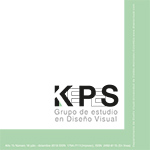Authors
Abstract
The objective of this article is to investigate what is the meaning of the relationship of telepresence that takes place in the artistic specular installation. A specular installation communicates two distant locations (in this case telematically, through signals transmitted over the Internet) developed with the same instructions: twin spatial configurations created on identical information but that, arising from two different assembly processes, acquired their own particularities which differentiate them from each other. Both sites have the same programming so, when communicating with each other, each one imitates the situation of the other. Each montage is a ‘mirror’ that reacts to its other –to the replica and the reflection of itself– in its location. The Entanglement (2005) work by Lozano-Hemmer is analytically studied, since it possesses these characteristics. In order to elaborate this analysis, it is assumed that the space emerges a-posteriori and it is constructed according to the context. In consequence, it is assumed that the space of the installation is dynamically established –among others– by the relationship between the context, the work and the public. Entanglement establishes four spatial levels of spatial construction as an installation: in general, non-site-specific, tele-present and specular. It seems to be that the configuration in this installation juxtaposes its spaces and times (by being tele-present), and each location –by reflecting the other– projects on an absence on itself, denying what it contains. It is concluded that, thanks to the infinite loop that is produced by the confrontation of ‘mirrors’, both assemblies of this work are superimposed evidencing in combination their absence and presence. This research aims to collaborate with other studies in this regard, so that the characteristics that are recognized in Entanglement contribute to the comprehension of other installations that have particularities and similar nature.
References
Altshuler, B. (1998). Art by Instruction and the Pre-History of do it. Recuperado de http://www.e-flux.com/projects-archive/do_it/notes/essay/e002.html.
Altshuler, B., Obrist, H. and Fowie, K. (2013). Do it: The Compendium. New York, USA: Independent Curators International.
Augé, M. (2000). Los “no lugares”: espacios del anonimato. Barcelona, España: Gedisa.
Barrios, J.L. (2015). Nada es más optimista que Stjärnsund: las paradojas del entusiasmo. En R. Lozano-Hemmer, Pseudomatismos (pp. 62-68). Ciudad de México, México: Museo Universitario de Arte Contemporáneo.
Benjamin, W. (2003). La obra de arte en la época de su reproductibilidad técnica. Ciudad de México, México: Itaca.
Bishop, C. (2008). El arte de la instalación y su herencia. Ramona, 78, 46-52.
Bishop, C. (2012). Delegated Performance: Outsourcing Authenticity. October, 140, 91-112.
Blanchot, M. (1965). Le rire des dieux. Nouvelle Revue Française, 151, 91-105.
Chung, K.-W. (2004). Borges y el espejo. En B. Mariscal y M. Miaja de la Peña, Actas del XV Congreso de la Asociación Internacional de Hispanistas “Las dos orillas” (pp. 101-114). Monterrey, México: Fondo de Cultura Económica.
Coulter-Smith, G. (2006). Deconstructing Installation Art. Recuperado de http://www.installationart.net/Chapter3Interaction/interaction02.html#attainingtheinteractive.
Davis, D. (1995). The Work of Art in the Age of Digital Reproduction (An Evolving Thesis: 1991-1995). Leonardo, 28 (5), 381-386.
De Oliveira, N., Oxley, N. and Petry, M. (2003). Installation Art in the New Millennium: The Empire of the Senses. London, England: Thomas & Hudson.
Foucault, M. (1994). Espacios diferentes. En A. Cabrera, Toponimias: ocho ideas del espacio (pp. 31-38). Madrid, España: Fundación La Caixa.
Fried, M. (1998). Art and Objecthood: Essays and Reviews. Chicago, USA: University of Chicago Press.
Goodman, N. (2010). Los lenguajes del arte: aproximación a la teoría de los símbolos. Madrid, España: Paidós.
Groys, B. (2009). La topología del arte contemporáneo. Recuperado de http:// esferapublica.org/nfblog/la-topologia-del-arte-contemporaneo/.
Kwon, M. (2000). Um lugar após o outro. Arte & Ensaios, 7, 166-187.
Kabakov, I. (2006). La instalación total. En J. Larrañaga, Instalaciones (pp. 91- 99). San Sebastián, España: Nerea.
Labastida, A. (2015). Tercero incluido o La máquina y su doble. En R. LozanoHemmer, Pseudomatismos (pp. 14-21). Ciudad de México, México: Museo Universitario de Arte Contemporáneo.
Larrañaga, J. (2006). Instalaciones. San Sebastián, España: Nerea.
Levinson, J. (2011). Music, Art and Metaphysics. New York, USA: Oxford University Press.
Lissitzky, E. (1995). A. and Pangeometry. En S. Yates (Ed.), Poetics of Space: A Critical Photographic Anthology (pp. 67-75). Albuquerque, USA: University of New Mexico.
Lozano-Hemmer, R. (2012). Alien Media: An Interview with Rafael Lozano-Hemmer. Recuperado de http://www.inflexions.org/n5_lozanohemmerhtml.html.
Manovich, L. (2012). Distancia y aura en las telecomunicaciones. Recuperado de https://redfilosoficadeluruguay.wordpress.com/2012/08/16/distancia-yaura-en-las-telecomunicaciones-lev-manovich/.
Reiss, J. (1999). From Margin to Center: The Spaces of Installation Art. Cambridge, USA: MIT Press.
Restrepo, J. (2005). Summa Technologiae: la obra de arte en la época de la reproductibilidad electrónica. En I. Hernández García, Estética, ciencia y tecnología: creaciones electrónicas y numéricas (pp. 225-233). Bogotá, Colombia: Pontificia Universidad Javeriana.
Toledo, R. (2002). Territorios y cuerpos. En A. Piedrahita et al., Codificar/ decodificar: prácticas, espacios y temporalidades del audiovisual en Internet (pp. 17-35). Bogotá, Colombia: Pontificia Universidad Javeriana.
Urrutia, J. (2015). Luz–ciencia, tecnología y arte. En R. Lozano-Hemmer, Pseudomatismos (pp. 8-13). Ciudad de México, México: Museo Universitario de Arte Contemporáneo.
Virilio, P. (1992). Big Optics. En P. Weibel, On Justifying the Hypothetical Nature of Art and the Non-Identically within the Object World. Berlin, Germany: Walther Konig.

 pdf (Español (España))
pdf (Español (España))
 FLIP
FLIP






















